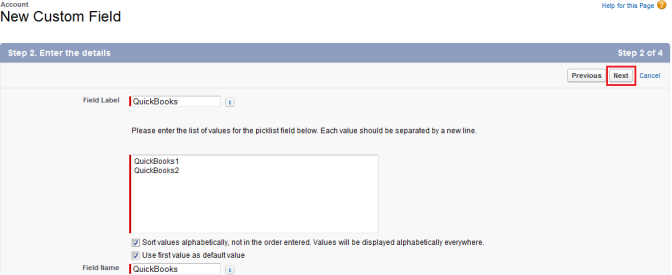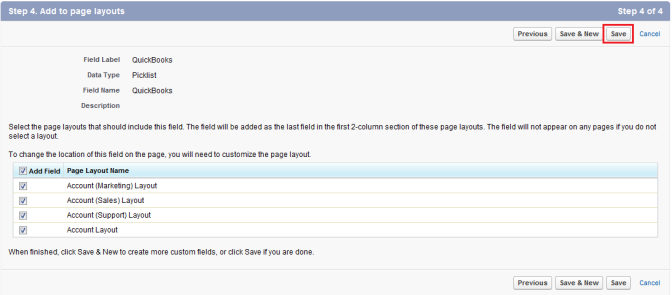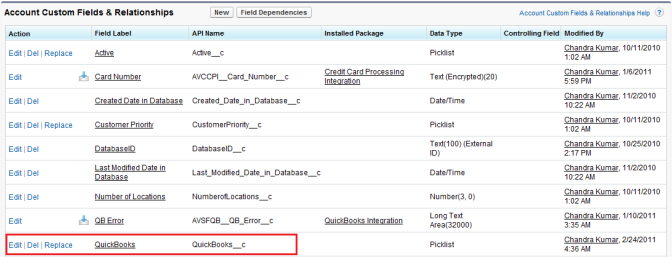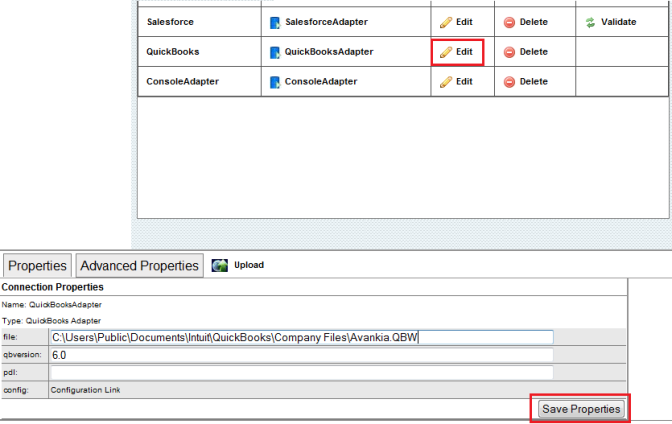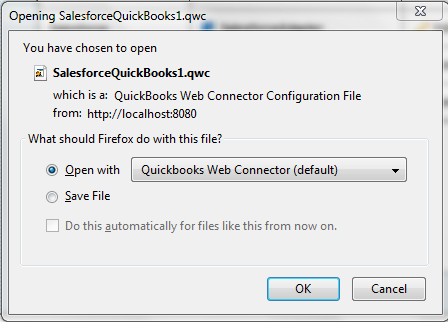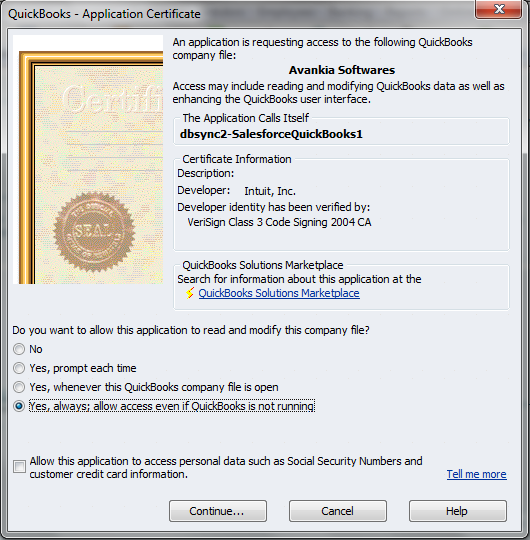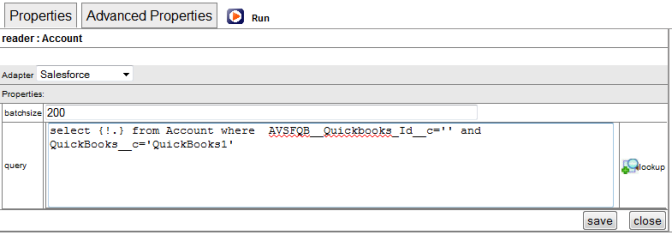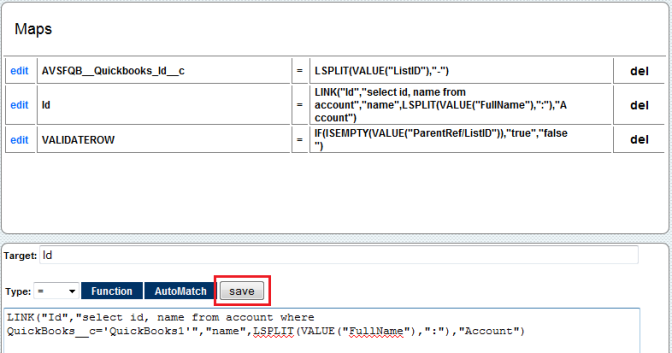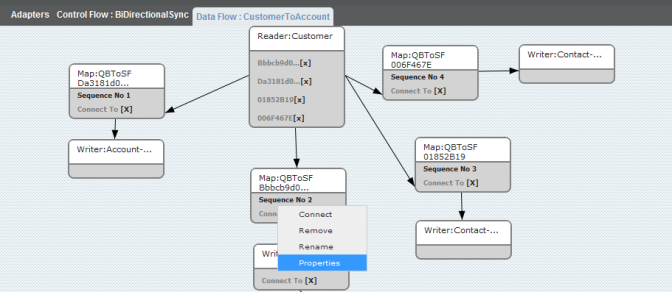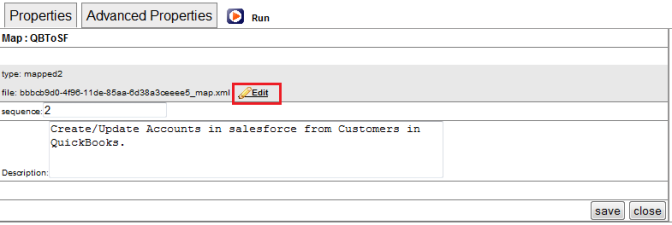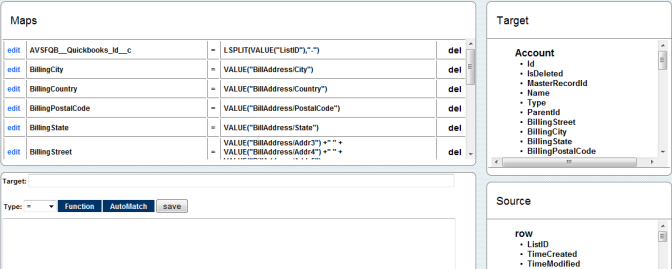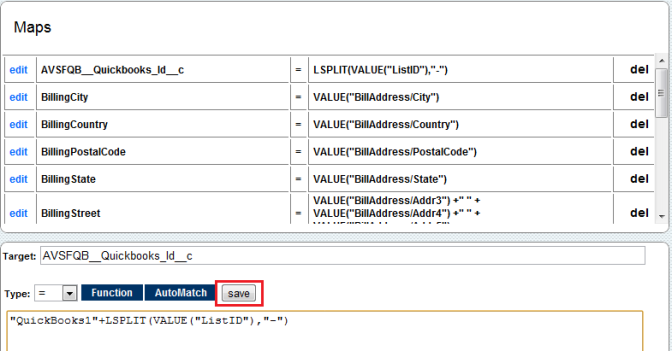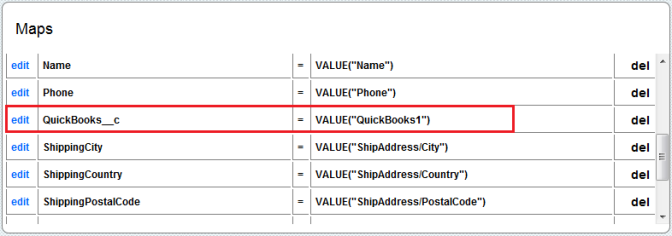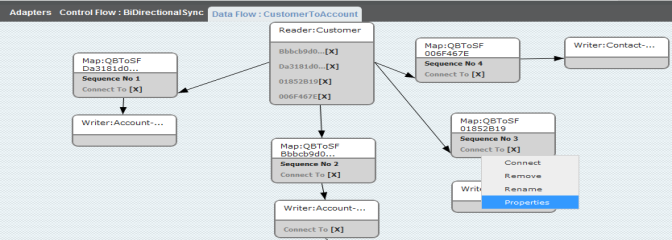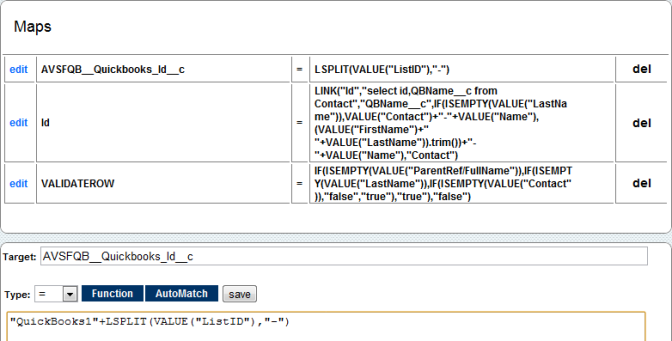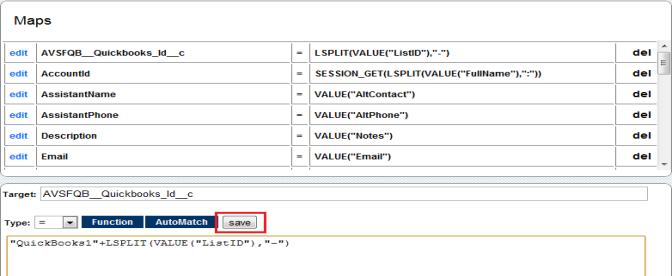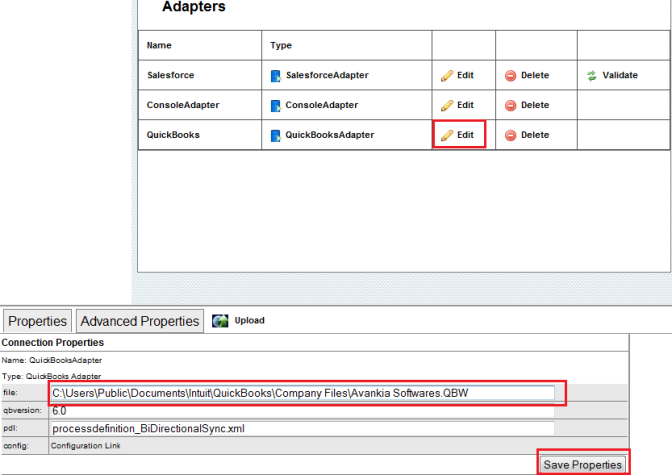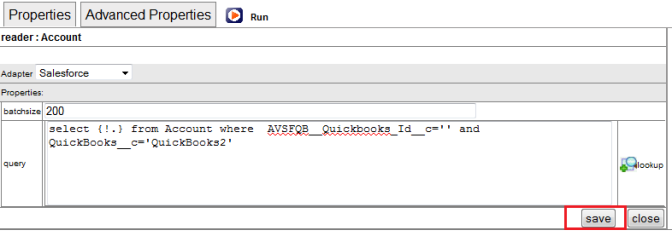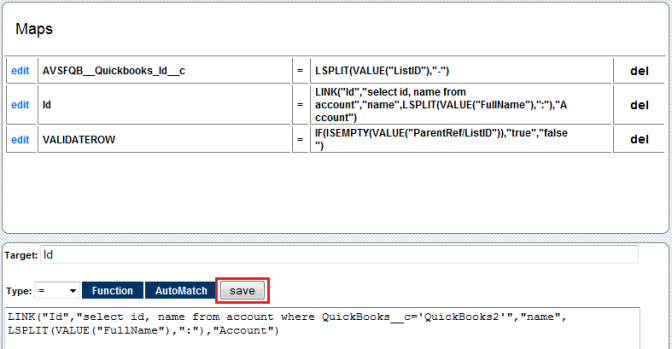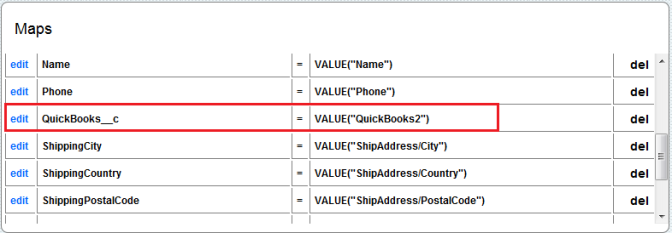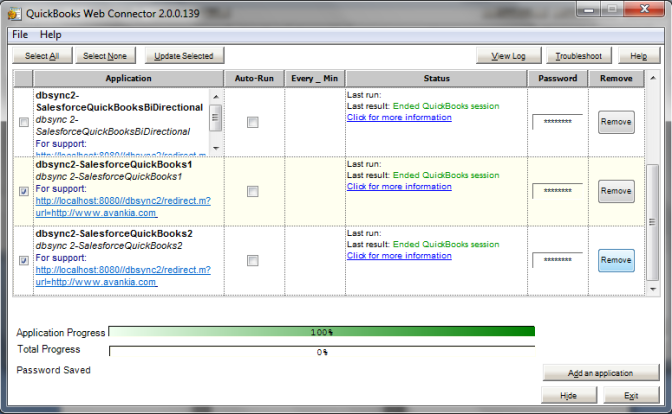2022
Page History
Salesforce QuickBooks Integration with Multiple QuickBooks File
- To integrate multiple QuickBooks with Salesforce using DBSync, we need to create multiple profiles Projects in DBSync and define identity . And, define the identifier field in each Salesforce Object we require in that is part of the integration.
- In this Demo I will show section, we discuss how different Salesforce Accounts are integrating with different QuickBooks Instances. Similarly, the integration shown discussed will also demonstrate each new Account created using QuickBooks Customer. Furthermore, it will be marked for specific QuickBooks Instances. So the integration flow will be Bi-Directional for Account to between Accounts and Customer.
- I have created 2 profiles Two Projects need to be created in DBSync, namely:
- SalesforceQuickBooks1
- SalesforceQuickBooks2
- Go to your Salesforce and Open Setup ? Customize ? Account ? Fields and click on New button in In Salesforce, click on and Setup > Customize > Account > Fields. Then, click on New in Account Custom Field and Relationships.
- Select the Picklist Option button and click on click Next.
- Enter the field label , enter and list of values for picklist , - in this demo, I am using 2 values as - "QuickBooks1" and "QuickBooks2". Select all the check boxes checkboxes and click on click Next.
- In the Next Screen, select the Profiles and fields that you want to make field visible and click on visible. Then, click Next.
- On Add to Page Layout, select the page layout Page Layout you want to add the fields to and click on Save button to too. Then, click Save to save and create the custom fields.
- The Field is created and can be viewed in the Accounts Custom Fields and Relationships section of Account Fields.
- Go to Account in your Salesforce and . Then, open any an account. Here in In this tutorial, I will open am opening Delphi Chemicals.
- Select QuickBooks1 from the QuickBooks picklist and click on Save.
- Similarly, open one more Account in your Salesforce and select QuickBooks2 from the QuickBooks field. In this tutorial, I will mark Abbott Insurance as the second Account.
- Select QuickBooks2 from the QuickBooks Field and click on click Save.
- Go to www.mydbsync.com login . Login to your account and Launch DBSync applicationclick on Development Studio.
- Click on Manage ? Edit for Project SalesforceQuickBooks1 profile.
- Click on Edit Link for QuickBooks Adapter, enter your first QuickBooks file path and click on Save.
- Click on the Configuration Link for QuickBooks Adapter, select open with "QuickBooks Web Connector" and click on OK button. Both the windows are shown below respectively.
- Click on OK in the next window. Select Option button "Yes always allow access" and click on continue button. The Profile will get added to QuickBooks Web Connector.
- Right Click on BiDirectionalSync process and select Open to open the integration profile.
- On AccountToCustomer state, select the IsActive check box and click on Save button to save the states. Double click on the AccountToCustomer State to open it.
- Right Click on Open on the Reader:Account Dataflow to open the properties of the reader. In the query section enter query as below and click on Save.
...
- On the left panel of Project console, click on Connectors. You will see Salesforce and QuickBooks Connectors. Make sure that both the Connectors are validated.
- Go to the Project SalesforceQuickBooks1 and make sure that the workflow AccountToCustomer is active - i.e. its status should be On.
- Open workflow AccountToCustomer. In the Advanced Query Builder, you see a query. Edit the query - as shown below - and click Save Workflow.
Code Block select {!.} from Account where AVSFQB__QuickBooks_Id__c=' ' and QuickBooks__c='QuickBooks1'
- Click on Save & Close button on the top right and click on OK to save the changes.
- In the Control Flow window, select the IsActive check box for CustomerToAccount and click on Save button to save the states. Double click on the CustomerToAccount State to open it.
- Right click on Properties on Map: QBToSF with "Sequence Number 1" to open the properties for mapping.
- Click on Edit Link for *********_map.xml file to open the mapping window. Both the screenshot is shown below respectively.
- Click on the Edit Link for first mapping in the list i.e. AVSFQB_QuickbooksMake sure workflow CustomerToAccount is active by keeping the status on.
- Open workflow CustomerToAccount. Here, you will see a list of available Rules at the bottom.
...
- Open the rule "Sequence No 1" and click map. You will see mapping AVSFQB_QuickBooks_idc = (VALUE("ListID")) _and edit this mapping as follows AVSFQB_QuickBooks_id__c = LSPLIT( VALUE("ListID") ) and Enter following mapping for the field and click on Save button.
...
- edit this mapping as follows AVSFQB_QuickBooks_id__c = "QuickBooks1"+
...
- VALUE("ListID")
...
- Click on the Edit Link for second mapping in the list i.e.
- The next mapping is Id = Link(*). Enter following mapping for the field and click on Save button: Edit this mapping as shown below and click Save and Close.
Id=select id, name from account where QuickBooks__c='QuickBooks1'
- Go back to DBSync console and Right click on Properties on Map:QBToSF with to rule "Sequence Number No 2" to open the properties for mappingof CustomerToAccount Workflow.
- Click on Edit Link for *********_map.xml file to open the mapping window. Both the screenshot is shown below respectively.
- Click on the Edit Link for first mapping in the list i.e. AVSFQB_QuickbooksClick on Map and you will see mapping AVSFQB_QuickBooks_id__c = LSPLIT (VALUE("ListID")) and Enter following mapping for the field and click on Save button..
- Edit this mapping as shown below:
AVSFQB_
...
QuickBooks_id__c = "QuickBooks1"+
...
(VALUE("ListID"),"-").
- Add a mapping in this window as QuickBooks__c = Value("QuickBooks1")
- Go back to DBSync console and Right Click on Properties on Map:QBToSF with "Sequence Number 3" to open the properties for mapping.
- Click on the Edit Link for first mapping in the list i.e. AVSFQB_Quickbooks.
- Now go to "Sequence No 3" of QuickBooksToSalesforce Workflow.
- Click on Map and you will see the mapping AVSFQB_QuickBooks_id__c = VALUE("ListID") and edit this mapping as follows AVSFQB_QuickBooks_id__c = LSPLIT("QuickBooks1"+VALUE("ListID")) and Enter
- Edit the following mapping for the field as below and click on the Save & Close button.
AVSFQB_
...
QuickBooks_id__c = "QuickBooks1"+
...
(VALUE("ListID"),"-").
- Go back to DBSync console and Right Click on Properties on Map: QBToSF with "Sequence Number 4" to open the properties for mapping by using the Edit Link in properties section.Click on the Edit Link for first mapping in the list i.e. AVSFQB_QuickbooksNo 4" of workflow CustomerToAccount and click on Map.
- You will see mapping AVSFQB_QuickBooks_id__c = LSPLIT (VALUE("ListID")) and Enter following mapping for the field and .
- Edit this mapping as below click on Save & Close button.
AVSFQB_
...
QuickBooks_id__c = "QuickBooks1"+
...
(VALUE("ListID"),"-")
...
- Close the mapping window and go back to DBSync console. Click on the profile link on the top right corner of the screen, to move to profiles in the DBSync.
...
.
- Go to Project SalesforceQuickBooks2 and open it for editing.
- Click on Edit Link for QuickBooks Adapter and enter the second QuickBooks file path. Click on Save button to save the properties.
- Click on the Configuration Link for QuickBooks Adapter, select open with "QuickBooks Web Connector" and click on OK button. Follow the steps shown earlier in the tutorial to add the profile to web connector.
- Right Click on BiDirectionalSync process and select Open to open the integration profile.
- On AccountToCustomer state, select the IsActive check box and click on Save button to save the states. Double click on the AccountToCustomer State to open it.
- Right Click on Open on the Reader:Account Data flow to open the properties of the reader. In the query section enter query as mentioned below and click on Save.
Wiki Markup *select {\!.} from Account where AVSFQB\_*{*}{_}Quickbooks_Id{_}{*}{*}{_}c='' and QuickBooks\__{*}*\_c='QuickBooks2'*
- Click on Save & Close button on the top right and click on OK to save the changes.
- In the Control Flow window, select the IsActive check box for CustomerToAccount and click on Save button to save the states. Double click on the CustomerToAccount State to open it.
- Right click on Properties on Map:QBToSF with "Sequence Number 1" to open the properties for the mapping.
- Click on Edit Link for *********_map.xml file to open the mapping window. Both the screenshot is shown below respectively.
- Click on the Edit Link for second mapping in the list i.e. Id = Link(*). Enter following mapping for the field and click on Save button:On the left panel of Project console, click on Connectors. Here, you will see Salesforce and QuickBooks Connectors. Make sure that both the Connectors are validated.
- Go to the Project SalesforceQuickBooks2 and make sure that the workflow AccountToCustomer is active - i.e. Its status should be On.
- Open workflow AccountToCustomer. In the Advanced Query Builder, you see a query. Edit the query as shown below and click Save Workflow.
Code Block select {!.} from Account where AVSFQB__QuickBooks_Id__c=' ' and QuickBooks__c='QuickBooks2'- Make sure workflow CustomerToAccount is active by keeping the status on.
- Open workflow CustomerToAccount. Here, you will see a list of available Rules at the bottom.
- Open the rule "Sequence No 1" and click map. Here, you will see mapping AVSFQB_QuickBooks_idc = VALUE("ListID") and edit this mapping as follows AVSFQB_QuickBooks_id__c ="QuickBooks2"+(VALUE("ListID"),"-").
- The next mapping is Id = Link(*). Edit this mapping as below and click on Save and Close.
Id=select id, name from account where QuickBooks__c='QuickBooks2'
- Go back to DBSync console and right click on Properties on Map:QBToSF with to rule "Sequence Number No 2" to open the properties for the mappingof CustomerToAccount Workflow.
- Click on Edit Link for *********_map.xml file to open the mapping window. Both the screenshot is shown below respectively.
- Click on Map. Here, you will see mapping AVSFQB_QuickBooks_id__c = (VALUE("ListID")).
- Edit this mapping as below:
AVSFQB_QuickBooks_id__c = "QuickBooks2"+(VALUE("ListID"),"-").
- Add a mapping in this window as as QuickBooks__c = Value("QuickBooks2").
- Go back to DBSync console and Right Click on Properties on Map: QBToSF with Go to "Sequence Number No 3" to open the properties for mappingof QuickBooksToSalesforce Workflow.
- Click on the Edit Link for first mapping in the list i.e. AVSFQB_QuickbooksMap here and you will see the mapping AVSFQB_QuickBooks_id__c = LSPLIT("QuickBooks1"+VALUE("ListID") ) and Enter
- Edit the following mapping for the field and click on Save button.
...
- as shown below and click Save & Close.
AVSFQB_QuickBooks_id__c = "QuickBooks2"+
...
(VALUE("ListID"),"-").
- Go back to DBSync console and *Right Click on Properties* on Map:QBToSF with "Sequence Number No 4" to open the properties for mapping.Click on the Edit Link for first mapping in the list i.e. AVSFQB_Quickbooksof workflow CustomerToAccount and click on Map.
- You will see mapping AVSFQB_QuickBooks_id__c = LSPLIT (VALUE("ListID")) and Enter following mapping for the field and click on Save button.
- Edit this mapping as shown below click Save & Close.
AVSFQB_
...
QuickBooks_id__c = "QuickBooks2"+
...
(VALUE("ListID"),"-").
- Close the mapping window. Go to QuickBooks Web Connector, enter . Enter your DBSync password for both the profiles, select . Select the profiles and click on Update Selected to start the sync.
- The Sync will start and it will update Salesforce Accounts as Customers in QuickBooks and Similarily All . Similarly, all the Customers of QuickBooks that don't exist in Salesforce will be created in Salesforce with an identity field marked for specific QuickBooks File.
- That's how DBSync handles Multiple QuickBooks file or instance. One thing to keep in mind, before following this step is the aforementioned steps, is that you need different DBSync QuickBooks Licenses if you are using more than one QuickBooks file. You can also configure each Profile in separate QuickBooks Web Connector instances , if you are running QuickBooks on more than one machine.
...
Overview
Content Tools



